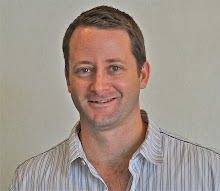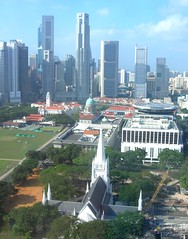Shiny Happy Singaporeans
Singapore recruits companies the way Duke recruits basketball players -- for the long haul. The country knows that one of its real risks is that its standard of living could price itself out of the market for foreign direct investment. According to a presentation to us by the US Embassy, Singapore hosts 7,000 multi-national companies, of which 1,500 are from the US.
In spite of its running-away success at luring foreign direct investment, Singapore's ruling PAP (People's Action Party) worries extensively about how it could lose it. Hence the security, the modern development, the aesthetics, the marvelous schools and the security (I know this is repetitious, but it's appropriate). You can't see the police, because they're all undercover, but you can rest assured that this place sweats terrorism in Indonesia, Malaysia and the Philippines like nobody's business. They've foiled a lot of plots since 9/11 and, as you might expect, they deal pretty severely with the perpetrators.
So Singapore is a real microcosm of that tradeoff between security and personal freedoms, and of a government for the people, but not necessarily by them. PAP holds all but two parliament seats and all they can think about is how to win those seats. They control most of the public discourse and, by virtue of their 100% stake in Temasek Holdings, the biggest private equity firm in the area, they control most media.
It also reminds me, in a way, of the uber-developed parts of Florida. Everything is gleaming and new, immaculately laid out, with well-defined districts that were all deliberately charted in the past few decades. No grandfathering, no accidents. Walk through any of Singapore's many shopping districts and brand names like Cartier, Hermes, Burberry and others parade the spotless streets. You may not be able to own real estate here, but, by God, you'll be immaculately tailored as you cruise about town in your 5-series Benz.
But there's nothing even vaguely indigenous about this place. Celebrating St. Patrick's Day here was farcical, in spite of having done so along a scenic strip of shops, bars and restaurants that line a riverwalk and sit across from the city's dazzling skyline.
A few stats and then a question: 8.4% growth in 2004; 3-5% expected for 2005. Resident unemployment was 3.7% in 2004, a significant improvement over last two years. So what's Singapore's encore? Now that you’ve packed this city/state with cash-rich corporations and ensconced the population with safety in every possible context, how do you fight complacency and prevent
I’d posit entrepreneurship. At some point, you’ve got to get as much of your growth organically as you do by essentially buying it with tax incentives. With 77% of its population Chinese, a historically entrepreneurial group, turning
US Embassy officials noted that, to stave off competition, the PAP simply co-opts the ideas of dissidents, offers them posts and thus absorbs, rather than combats, its competition. I wonder to what extent corporations here would use the same model, thus quashing startups. I also wonder to what extent banks and economic development groups here can shift their focus from foreign direct investment to indigenous new venture creation.









0 Comments:
Post a Comment
<< Home